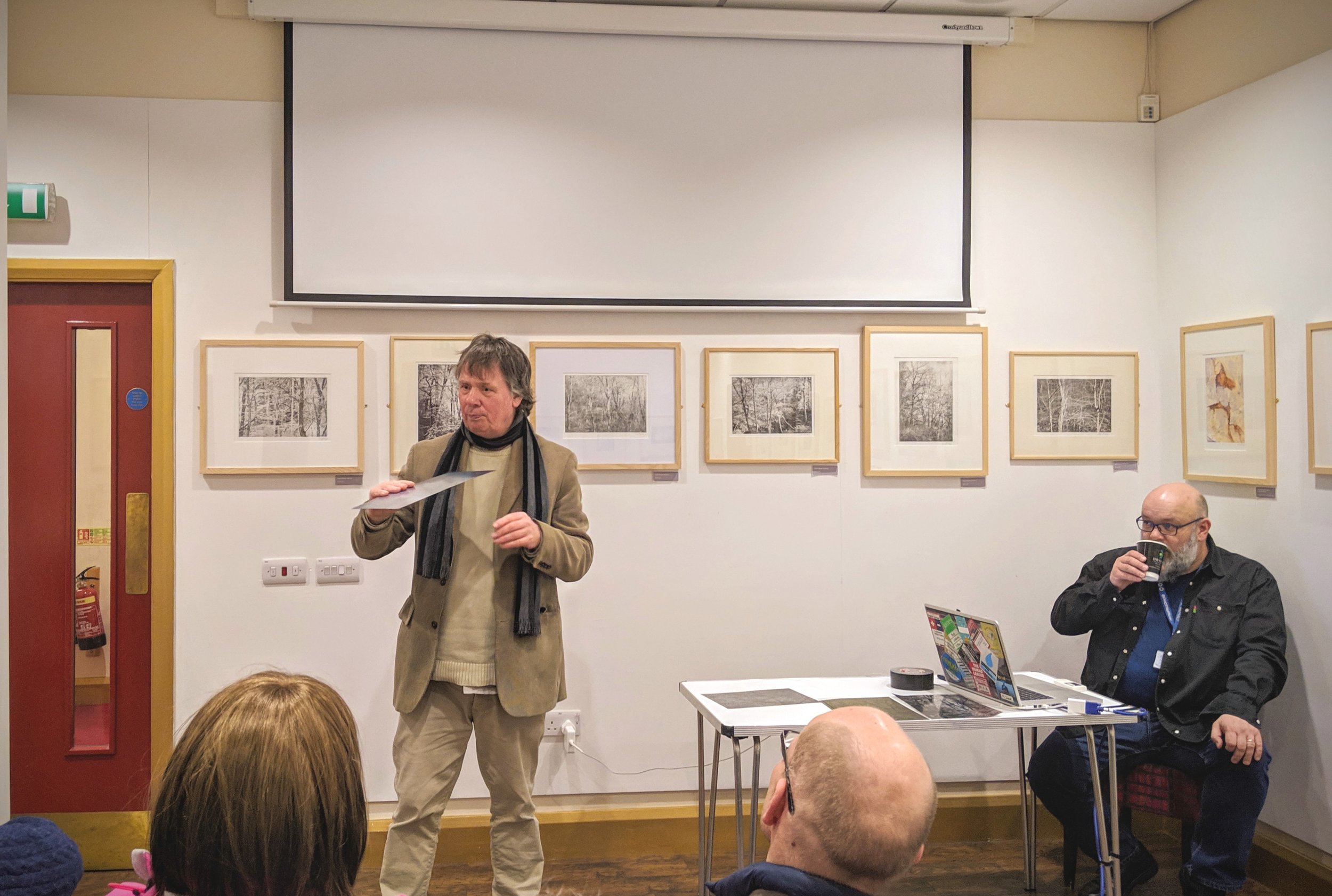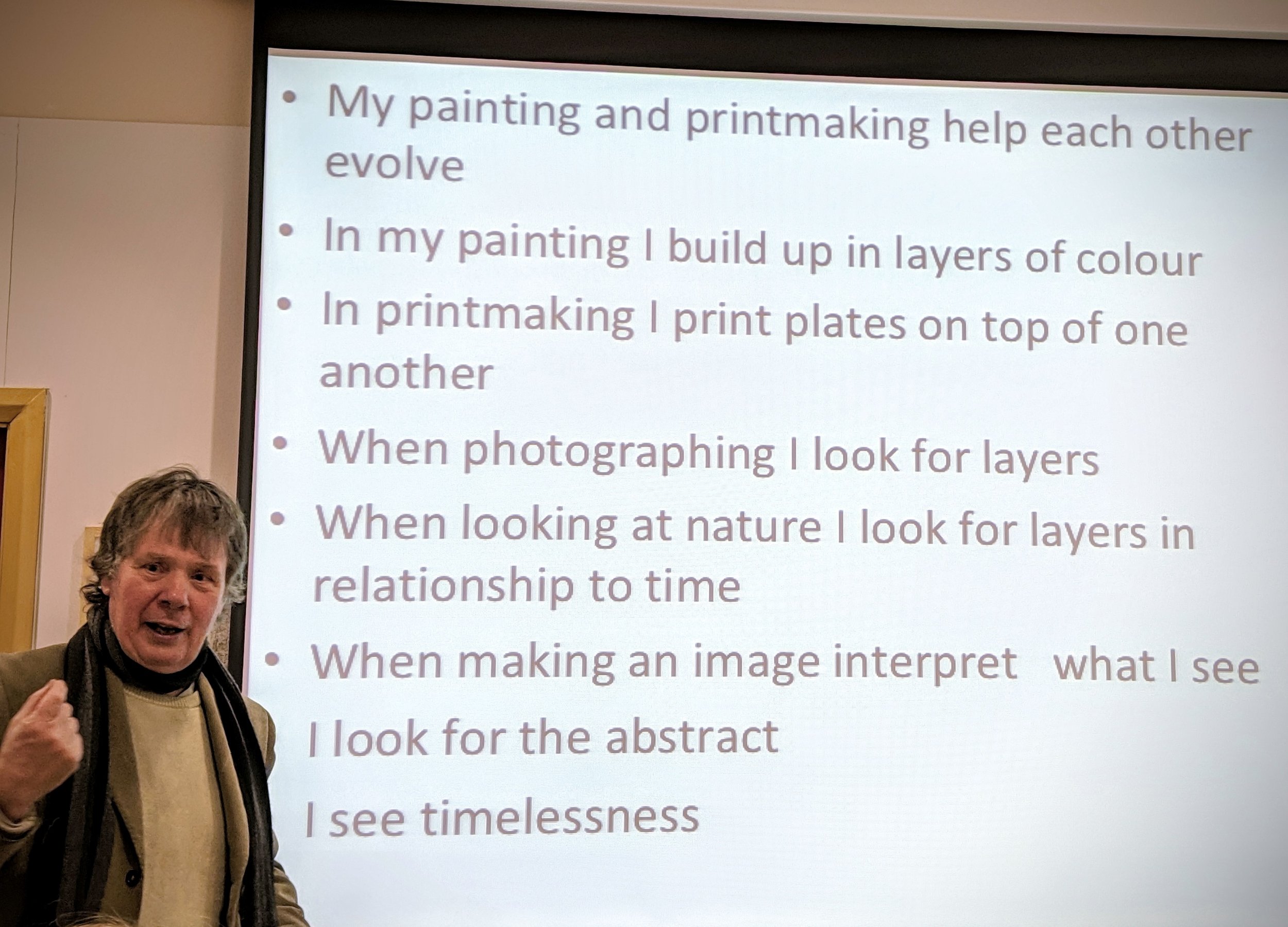The painter and printmaker John Hedley gave a talk on the work in his exhibition 'Fingertips in Time' at Oriel Colwyn on Thursday 7th March 2019. The exhibited images fall into two series, one of trees presented as monochrome prints which looked almost like charcoal sketches and the other, a series of multicoloured print studies of volcanic rock formations from two sites, one at Llandwyn Island on Anglesey and the other in Crete. John talked about the techniques he used in making these and also more extensively about his work in general including his paintings, sculpture and work with mixed media. My interest in his processes relates to his use of digital camera photographs as the starting point and how he went about transforming these into intaglio prints. He explained that he prints the photographs as a positive image at high resolution (600 dpi bitmapped) onto acetate, using an A3 inkjet photo quality printer. The acetate is then exposed in a UV light box (Natgraph) onto a photopolymer etching plate (Solar Plate), which when processed and prepared (polished) can be inked up for printing onto dampened paper in a press. He explained that until recently, he had been wary of using photography as he felt this was almost like cheating. When he started using a digital SLR camera he discovered that the learning process was more complicated than he had anticipated; the main difficulty being obtaining a perfect tonal range which would be compatible with his printmaking processes. After a fair amount of "learning by mistakes" he has found that photography and image processing (layering in Photoshop) is now influencing his painting which has become "more abstract, in a round about way". He feels the main difference between most photographers and painters is that photographers feel they need to know what the end result will be at the time they press the shutter - i.e. classic 'pre-visualisation' as advocated by Ansel Adams (Schaefer, 1992) and the f64 group (and most photographers since then). In his printmaking, especially with multiple layers of coloured inks, he seldom knows what it will look like when finished and part of the process of abstraction is that the image evolves layer by layer, as it is being made.
He explained that until recently, he had been wary of using photography as he felt this was almost like cheating. When he started using a digital SLR camera he discovered that the learning process was more complicated than he had anticipated; the main difficulty being obtaining a perfect tonal range which would be compatible with his printmaking processes. After a fair amount of "learning by mistakes" he has found that photography and image processing (layering in Photoshop) is now influencing his painting which has become "more abstract, in a round about way". He feels the main difference between most photographers and painters is that photographers feel they need to know what the end result will be at the time they press the shutter - i.e. classic 'pre-visualisation' as advocated by Ansel Adams (Schaefer, 1992) and the f64 group (and most photographers since then). In his printmaking, especially with multiple layers of coloured inks, he seldom knows what it will look like when finished and part of the process of abstraction is that the image evolves layer by layer, as it is being made. Expanding on this, he explained that in deciding what to photograph he looks for the the most obscure and abstract things he can find, often now looking in nature for visual representations of layers; one tree in front of others, shadows on rocks or sand, layers in dead wood or rock formations, layers in time. In interpreting what he can see, he is taking from nature then playing and abstracting from it. He described this process as "being like building with Lego - start with the finished object - take it apart then re-build it - it will look similar but not exactly the same".To my surprise, I found that I had more in common with his approach than I had expected. In discussion with the audience, he talked of shadows in art as having ambiguity, transience - similar to the feelings I have been trying to capture in my photographs of shadows. I had not previously grasped the significance of layers but in many of my images, that could be what gives them the impression of texture. I felt comfortable with his explanations of abstraction, a concept I have had difficulty fully understanding previously. He is clearly happy now using a hybrid of digital photography and traditional printing, feeding contemporary technology into long established analogue processes. He is going to be in Greece for the next couple of months but has offered to let some of us visit his studio to share his technical knowledge. Having never seen photo-etching in practice or intaglio prints being made, I still have some difficulty in understanding exactly how it works and this is now on my list to do over the summer. I am sure that the learning curve for developing his printmaking skills was much steeper and longer than it took him to get what he needed from digital photography but I am still interested in printing digital negatives on acetate for use with historical U-V light based photographic processes and his advice on file preparation and printing technique could be invaluable.His final comment on his acceptance of photography as a tool for image making was to concede that "the mobile phone has become the sketch-book of the 21st century".The images used to illustrate this post were captured on my mobile phone camera.Schaefer JP (1999) 'Visualisation: The Art of Seeing a Photograph' In: Ansel Adams Guide - Basic Techniques of Photography Book (1); Revised edition, Boston-New York-London, Little, Brown and Company, pp 131-134.
Expanding on this, he explained that in deciding what to photograph he looks for the the most obscure and abstract things he can find, often now looking in nature for visual representations of layers; one tree in front of others, shadows on rocks or sand, layers in dead wood or rock formations, layers in time. In interpreting what he can see, he is taking from nature then playing and abstracting from it. He described this process as "being like building with Lego - start with the finished object - take it apart then re-build it - it will look similar but not exactly the same".To my surprise, I found that I had more in common with his approach than I had expected. In discussion with the audience, he talked of shadows in art as having ambiguity, transience - similar to the feelings I have been trying to capture in my photographs of shadows. I had not previously grasped the significance of layers but in many of my images, that could be what gives them the impression of texture. I felt comfortable with his explanations of abstraction, a concept I have had difficulty fully understanding previously. He is clearly happy now using a hybrid of digital photography and traditional printing, feeding contemporary technology into long established analogue processes. He is going to be in Greece for the next couple of months but has offered to let some of us visit his studio to share his technical knowledge. Having never seen photo-etching in practice or intaglio prints being made, I still have some difficulty in understanding exactly how it works and this is now on my list to do over the summer. I am sure that the learning curve for developing his printmaking skills was much steeper and longer than it took him to get what he needed from digital photography but I am still interested in printing digital negatives on acetate for use with historical U-V light based photographic processes and his advice on file preparation and printing technique could be invaluable.His final comment on his acceptance of photography as a tool for image making was to concede that "the mobile phone has become the sketch-book of the 21st century".The images used to illustrate this post were captured on my mobile phone camera.Schaefer JP (1999) 'Visualisation: The Art of Seeing a Photograph' In: Ansel Adams Guide - Basic Techniques of Photography Book (1); Revised edition, Boston-New York-London, Little, Brown and Company, pp 131-134.
